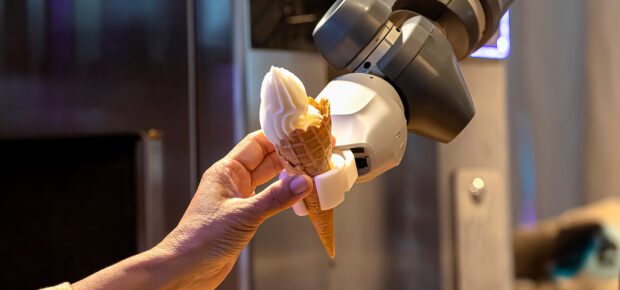September 5, 2024
There’s a common maxim in robotics: tasks that are easy for robots are hard for humans, and tasks that are easy for humans are hard for robots.
Robots can play chess, perform surgery and build cars on the assembly line – all things many humans would struggle to do proficiently. But ask a robot to do something humans do every day, like make coffee in a kitchen or buy groceries in a store, and most would fail.
Over the past few years, robots have gotten better at doing easy things. And hard ones, too.
“During the last decade, robots have slowly but consistently become more versatile,” said IEEE Member Juan Galindo. “Even though robots have not achieved total autonomy for complex tasks, they can perform multiple tasks with little human supervision. In agriculture, robots can perform irrigation, sow crops and measure soil humidity. In industrial environments, they are able to move objects of different sizes, perform soldering and screwing together multiple pieces. Drone swarms are also being used to control forest fires, determining when and where they have to carry or drop water and when to recharge.”
And while they’re not everywhere (yet), robots are being used more than you might know.
By The Numbers
According to the International Federation of Robotics, the proportion of robots in industrial settings doubled between 2017 and 2022, from 85 robots per 10,000 workers to 151 robots per 10,000 workers. The figures speak to increasing levels of automation in factory settings. South Korea leads the world in robot density, with about 1,000 robots per 10,000 workers.
In the U.S., robotics account for about 1% of all equipment sales, or about $12 billion annually.
Robots (Almost) Everywhere
Here’s a look at some ways robots are being deployed:
Sorting Recyclable Materials: Many recycling programs use “single stream” bins where glass, plastic, and aluminum are mixed. Machines, sometimes aided by humans, sort these materials, but inaccuracies still occur, leading to recyclables being misclassified or sent to landfills. To improve sorting accuracy, companies are now incorporating AI into robotic systems. Companies are adding artificial intelligence to robotic sorting machines to improve accuracy.
Food Delivery Robots: In recent years, college campuses have seen an influx of four-wheeled drones that deliver snacks and hot meals. These drones have also expanded to other locations, such as airports, office parks, and even urban environments.
Robotic Chefs: Robots seem ideal for repetitive restaurant tasks like food prep, but the complexity of fresh ingredients and human techniques has slowed adoption. One robotics company, however, has successfully made 20 million highly repeatable meals. Beyond cooking, robots are also being used to serve food and even clean tables.
Security Guards: Those four-legged robots you’ve seen so many videos of can monitor property to prevent vandalism and trespassing. .
Robotic Surgery: Surgical robots can reduce recovery times because the incisions they make are smaller. According to the IEEE Engineering in Medicine and Biology Society, one of the most popular robot surgery models had performed 10 million procedures by 2021.
Robotic Cameras: Broadcast sports rely on robotic cameras to capture the action. The cameras are usually controlled remotely by operators in a booth, allowing broadcast teams to place cameras in places that humans could not go, like in confined spaces. Some cameras are also infused with machine vision. When used as security cameras, these can identify whether a human has entered a restricted area. Another body of research has been working on giving robotic cameras more autonomy, even at the consumer level.
Robots in Retail: Robots have made increasing inroads inside warehouses, where they transport inventory and pick items for shipping. They’re also being deployed in retail settings. They can perform inventory duties, patrolling the aisles, scanning RFID tags to monitor stock levels, or looking for trash.
Better Parts, Less Money
Behind the scenes, improvements in robotics has been driven by better access to low-cost sensors and the rise of artificial intelligence.
“Better hardware, such as improved sensors and more powerful processors, allows robots to gather and process data more efficiently,” said IEEE Senior Member Ming Liu. Meanwhile, using machine learning and artificial intelligence enables robots to learn from this data, improving their performance over time.”
Natural language processing, which allows people to interact with robots like they would speak to another human, may further accelerate robot use.
“With NLP, humans can communicate with robots using natural language,” Liu said, “making it easier for non-experts to interact with and control them. This could also lead to more intuitive and user-friendly programming interfaces for robots.”
Household Robots Still a Long Way Away
Robots that will vacuum your home have been around for decades. A general-purpose household robot, one that can make coffee, clean the shower, and do the laundry, is probably a long way away.
That’s because most robots are built for very specific tasks (like vacuuming), often in tightly controlled environments, to reduce the risk of error.
Some tech enthusiasts are trying, and that is leading to real improvements in household robotics. You can read about one such effort here.





 Meaningful Momentum or Running in Place?
Meaningful Momentum or Running in Place? AI Through Our Ages
AI Through Our Ages Liquid Infrastructure: Our Planet's Most Precious Resource
Liquid Infrastructure: Our Planet's Most Precious Resource The Impact of Technology in 2025
The Impact of Technology in 2025 Quantum and AI: Safeguards or Threats to Cybersecurity?
Quantum and AI: Safeguards or Threats to Cybersecurity? Why AI Can't Live Without Us
Why AI Can't Live Without Us Bits, Bytes, Buildings and Bridges: Digital-Driven Infrastructure
Bits, Bytes, Buildings and Bridges: Digital-Driven Infrastructure Impact of Technology in 2024
Impact of Technology in 2024 Emerging AI Cybersecurity Challenges and Solutions
Emerging AI Cybersecurity Challenges and Solutions The Skies are Unlimited
The Skies are Unlimited Smart Cities 2030: How Tech is Reshaping Urbanscapes
Smart Cities 2030: How Tech is Reshaping Urbanscapes Impact of Technology 2023
Impact of Technology 2023 Cybersecurity for Life-Changing Innovations
Cybersecurity for Life-Changing Innovations Smarter Wearables Healthier Life
Smarter Wearables Healthier Life Infrastructure In Motion
Infrastructure In Motion The Impact of Tech in 2022 and Beyond
The Impact of Tech in 2022 and Beyond Cybersecurity, Technology and Protecting Our World
Cybersecurity, Technology and Protecting Our World How Technology Helps us Understand Our Health and Wellness
How Technology Helps us Understand Our Health and Wellness The Resilience of Humanity
The Resilience of Humanity Harnessing and Sustaining our Natural Resources
Harnessing and Sustaining our Natural Resources Creating Healthy Spaces Through Technology
Creating Healthy Spaces Through Technology Exceptional Infrastructure Challenges, Technology and Humanity
Exceptional Infrastructure Challenges, Technology and Humanity The Global Impact of IEEE's 802 Standards
The Global Impact of IEEE's 802 Standards Scenes of our Cyber Lives: The Security Threats and Technology Solutions Protecting Us
Scenes of our Cyber Lives: The Security Threats and Technology Solutions Protecting Us How Millennial Parents are Embracing Health and Wellness Technologies for Their Generation Alpha Kids
How Millennial Parents are Embracing Health and Wellness Technologies for Their Generation Alpha Kids Space Exploration, Technology and Our Lives
Space Exploration, Technology and Our Lives Global Innovation and the Environment
Global Innovation and the Environment How Technology, Privacy and Security are Changing Each Other (And Us)
How Technology, Privacy and Security are Changing Each Other (And Us) Find us in booth 31506, LVCC South Hall 3 and experience the Technology Moon Walk
Find us in booth 31506, LVCC South Hall 3 and experience the Technology Moon Walk Virtual and Mixed Reality
Virtual and Mixed Reality How Robots are Improving our Health
How Robots are Improving our Health IEEE Experts and the Robots They are Teaching
IEEE Experts and the Robots They are Teaching See how millennial parents around the world see AI impacting the lives of their tech-infused offspring
See how millennial parents around the world see AI impacting the lives of their tech-infused offspring Take the journey from farm to table and learn how IoT will help us reach the rising demand for food production
Take the journey from farm to table and learn how IoT will help us reach the rising demand for food production Watch technical experts discuss the latest cyber threats
Watch technical experts discuss the latest cyber threats Explore how researchers, teachers, explorers, healthcare and medical professionals use immersive technologies
Explore how researchers, teachers, explorers, healthcare and medical professionals use immersive technologies Follow the timeline to see how Generation AI will be impacted by technology
Follow the timeline to see how Generation AI will be impacted by technology Learn how your IoT data can be used by experiencing a day in a connected life
Learn how your IoT data can be used by experiencing a day in a connected life Listen to technical experts discuss the biggest security threats today
Listen to technical experts discuss the biggest security threats today See how tech has influenced and evolved with the Games
See how tech has influenced and evolved with the Games Enter our virtual home to explore the IoT (Internet of Things) technologies
Enter our virtual home to explore the IoT (Internet of Things) technologies Explore an interactive map showcasing exciting innovations in robotics
Explore an interactive map showcasing exciting innovations in robotics Interactively explore A.I. in recent Hollywood movies
Interactively explore A.I. in recent Hollywood movies Get immersed in technologies that will improve patients' lives
Get immersed in technologies that will improve patients' lives